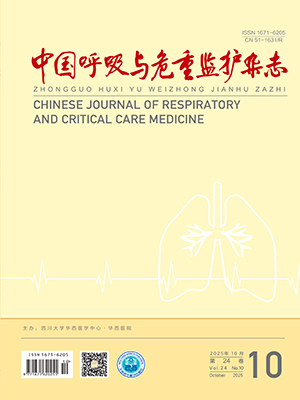| 1. |
Kang CI, Kim SH, Bang JW, et al. Community-acquired versus nosocomial Klebsiella pneumoniae bacteremia: clinical features, treatment outcomes, and clinical implication of antimicrobial resistance. J Korean Med Sci 2006, 21(5): 816-822.
|
| 2. |
Kobashi Y, Fujita K, Karino T, et al. Clinical analysis of community-acquired pneumonia requiring hospitalization in a community hospital--comparison of elderly and non-elderly patients.Kansenshogaku Zasshi. 2000, 74(1): 43-50.
|
| 3. |
Bansal S, Kashyap S, Pal LS, et al. Clinical and bacteriological profile of community acquired pneumonia in Shimla, Himachal Pradesh. Indian J Chest Dis Allied Sci 2004, 46(1): 17-22.
|
| 4. |
Huang HH, Zhang YY, Xiu QY, et al. Community-acquired pneumonia in Shanghai, China: microbial etiology and implications for empirical therapy in a prospective study of 389 patients. Eur J Clin Microbiol Infect Dis 2006, 25(6): 369-374.
|
| 5. |
社区获得性肺炎诊断和治疗指南(草案). 中华结核和呼吸杂志, 1999, 22(2): 199-2010.
|
| 6. |
中国成人社区获得性肺炎诊断和治疗指南(2016 版). 中华结核和呼吸杂志, 2016, 39(4): 241-20.
|
| 7. |
Guidelines for the management of adults with hospital-acquired, ventilator-associated, and healthcare-associated pneumonia. Am J Respir Crit Care Med. 2005, 171(4): 388–4160.
|
| 8. |
Nakai H, Hagihara M, Kato H, et al. Prevalence and risk factors of infections caused by extended-spectrum β-lactamase (ESBL)-producingEnterobacteriaceae.J Infect Chemother. 2016, 22(5): 319-26.
|
| 9. |
von Baum H, Welte T, Marre R, et al. Community-acquired pneumonia through Enterobacteriaceae and Pseudomonas aeruginosa: Diagnosis, incidence and predictors.Eur Respir J. 2010, 35(3): 598-605.
|
| 10. |
Rattanaumpawan P, Nachamkin I, Bilker WB, et al. Risk factors for ambulatory urinary tract infections caused by high-MIC fluoroquinolone-susceptible Escherichia coli in women: results from a large case-control study.J Antimicrob Chemother. 2015, 70(5): 1547-1551.
|
| 11. |
Sahuquillo-Arce JM, Menéndez R, Méndez R, et al. Age-related risk factors for bacterial aetiology in community-acquired pneumonia.Respirology. 2016, 21(8): 1472-1479.
|
| 12. |
Ko WC, Paterson DL, Sagnimeni AJ, et al. Community-acquired Klebsiella pneumoniae bacteremia: global differences in clinical patterns. Emerg Infect Dis. 2002, 8(2): 160-166.
|
| 13. |
ERuiz LA, Gómez A, Jaca C, et al. Bacteraemic community-acquired pneumonia due to Gram-negative bacteria: incidence, clinical presentation and factors associated with severity during hospital stay.Infection. 2010, 38(6): 453-458.
|
| 14. |
Kang CI, Song JH, Oh WS, et al. Clinical outcomes and risk factors of community-acquired pneumonia caused by gram-negative bacilli.Eur J Clin Microbiol Infect Dis. 2008, 27(8): 657-661.
|
| 15. |
Harbarth S, Rohner P, Auckenthaler R, et al. Impact and pattern of gram-negative bacteraemia during 6 y at a large university hospital. Scand J Infect Dis. 1999, 31(2): 163-168.
|
| 16. |
Hung IF, Zhang AJ, To KK, et al. Unexpectedly higher morbidity and mortality of hospitalized elderly patients associated with rhinovirus compared with influenza virus respiratory tract infection.Int J Mol Sci. 2017, 18(2): 259-268.
|
| 17. |
Reade MC, Weissfeld L, Angus DC, et al. The prevalence of anemia and its association with 90-day mortality in hospitalized community-acquired pneumonia.BMC Pulm Med. 2010, 10: 15.
|
| 18. |
Brancati FL, Chow JW, Wagener MM, et al. Is pneumonia really the old man's friend? Two-year prognosis after community-acquired pneumonia.Lancet. 1993, 342(8862): 30-33.
|
| 19. |
Waterer GW, Kessler LA, Wunderink RG. Medium-term survival after hospitalization with community-acquired pneumonia. Am J Respir Crit Care Med 2004, 15;169(8): 910-914.
|
| 20. |
Raz R, Dyachenko P, Levy Y, et al. A predictive model for the management of community-acquired pneumonia. Infection 2003, 31(1): 3-8.
|
| 21. |
John M, Hoernig S, Doehner W, et al .Anemia and inflammation in COPD. Chest 2005, 127(3): 825-829.
|
| 22. |
Yende S, D’Angelo G, Kellum JA, et al. Inflammatory markers at hospital discharge predict subsequent mortality after pneumonia and sepsis. Am J Respir Crit Care Med 2008, 177(11): 1242-1247.
|
| 23. |
Askim Å, Mehl A, Paulsen J, et al. Epidemiology and outcome of sepsis in adult patients with Streptococcus pneumoniae infection in a Norwegian county 1993-2011: an observational study. BMC Infect Dis. 2016, 23;16: 223.
|
| 24. |
Guillamet CV, Vazquez R, Noe J, et al. A cohort study of bacteremic pneumonia: The importance of antibiotic resistance and appropriate initial therapy? Medicine (Baltimore). 2016, 95(35): e4708.
|
| 25. |
Tumbarello M, Trecarichi EM, De Rosa FG, et al. Infections caused by KPC-producing Klebsiella pneumoniae: differences in therapy and mortality in a multicentre study. J Antimicrob Chemother. 2015, 70(7): 2133-2143.
|
| 26. |
Nseir S, Martin-Loeches I, Makris D, et al. Impact of appropriate antimicrobial treatment on transition from ventilator-associated tracheobronchitis to ventilator-associated pneumonia. Crit Care. 2014, 18(3): 129-136.
|
| 27. |
Chang-Hua C, Li-Chen L, Yu-Jun C, et al. Mortality analysis of Enterococcus faecium bloodstream infection in central Taiwan. Rev Chilena Infectol. 2016, 33(4): 395-402.
|
| 28. |
Bhengsri S, Lertiendumrong J, Baggett HC, et al. Economic burden of bacteremic melioidosis in eastern and northeastern, Thailand.Am J Trop Med Hyg. 2013, 89(2): 369-373.
|
| 29. |
冯军花, 何京, 杨青, 等. 临床分离肺炎克雷伯菌分布及耐药性分析. 中华医院感染学杂志, 2016, 26(22): 5053-50550.
|
| 30. |
刘朝晖, 陈劲龙, 叶惠芬, 等. 肺炎克雷伯菌社区获得性肺炎与医院获得性肺炎的比较研究. 中国呼吸与危重监护杂志, 2004, 3(5): 289-2920.
|




